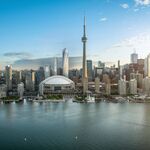Highway 7 used to jog at Yonge Street (Highway 11). It followed the first east-west sideroad north of Steeles Avenue (connecting Brampton, Woodbridge, and Thornhill), then continued along the second east-west sideroad north of Steeles Avenue to connect with Unionville, Markham, Brougham, and Brooklin. For a few decades, Yonge Street carried both Highways 7 and 11 for a short bit. The original route of Highway 7 jogs a lot between Sarnia and Ottawa, connecting towns and cities together along mostly existing concession roads and sideroads. The route straightened out a bit by way of re-routings and bypasses, like the one between Concord and Yonge Street which by-passed Thornhill, partially on a new alignment, partially via Langstaff Road.
The old route, Centre Street, was designated Highway 7B for a short period.




